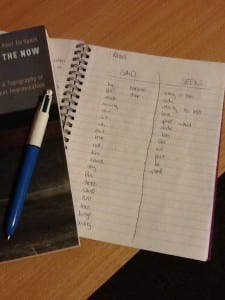Confidence is something that can take a while to build up but can be destroyed in a second. Just as I thought I was doing well, I now find myself struggling more than I was at the start, which is actually quite hard to admit. After discovering I may have torn one of my hamstrings and the thought of having to watch others improve their improvisation skills whilst I sit out wasting precious time, it gets you quite down.
When presented with the idea of still joining in, however with the limitation of not being to use my legs, I thought right okay, this gives me a chance to still improve by getting me to work with my injury, instead of being hindered by it. But then I had several questions:
• If I’m not allowed to use my legs, does that mean I’m meant to envisage having no legs? Dancing as though I exist only from the waist up?
• Are they there but not working? As if they are paralysed?
• Are they there, but I have to ignore the fact that they are there?
Don’t get me wrong, it was a great limitation to consider but it opened up so many different interpretations, it was rather overwhelming and so I felt a lot of added pressure in a room full of capable dancers. I tried to join in with the tasks given in class at first, but with the pressure of trying to make what I did look good, I felt as though I wasn’t doing it right. It also would have helped if my leg didn’t hurt whilst even being sat still. The part I found most difficult was finding ways to travel without using my legs, obviously I can use my arms to pull me across the floor, but combined with the tasks of trying to get the top of my head to touch my sit bones or imagining all the cells in my body are racing, it all seemed too much to think about. On the other hand there were some tasks that I felt I couldn’t join in with at all, such as the task that my left leg is leading the movement, which brought me back to my initial questions, do I even have legs? Whilst sat on the edge of the performance space, I had images of what I could do with this limitation, but felt I couldn’t due to the risk of injuring my leg further.
In dance, your legs are considered your most powerful tools, albeit not your only tool, and so I always believed that if I injure one of my tools its important to give it time to heal? And so, by attempting to participate in this week’s improvisation class, I felt I was contradicting myself and advice given to me. So many different arguments and ideas were floating round in my head at the time, but then I watched the work of David Toole. Here is a man with no legs using his arms as his main tools and being able to move seaminglessly across the floor, and here’s me complaining about a silly torn hamstring. So for now, I will give my leg time to heal but the idea of limitations will be something I come back to in the future.
This week we were asked to answer one of the following three questions from within one of our readings (Ribeiro and Fonseca, 2011, 72):
1. How is it possible to make a shared choice of movements during improvisation between two or more dancers, without previous agreement and communication through words?
2. What generates the sense nexus that is perceived when we watch a dance improvisation?
3. Can we call choreography what we see when we watch dance improvisation?
The first question seems rather straight forward, the second seemed a bit too in depth for my brain to handle and the third, however, actually made me stop and think. We typically define choreography as the arrangement of steps, or patterns, could the same not be applied to an improvisation with a set score? Although the movements aren’t specifically planned, the score is. In their article, Ribeiro and Fonseca reveal that “a person who watches a contemporary dance improvisation performance perceives a sequence of interlinked movements that has its own logic” (Ribeiro and Fonseca, 2011, 79). They argue that improvisation can in fact have its own logic due to the link between the dancers on stage, linking to question one. The capability of the dancers to form a connection with one another, is based on empathy, to allow themselves to make similar decisions and this contributes to the overall logic of the improvisation. Empathy is “a process that enables the understanding of emotions and intentions among people” (Ribeiro and Fonseca, 2011, 73) and is what allows the dancers to participate in non premeditated joint decision-making, therefore adding to the temporary structure or temporary choreography of the piece in the present moment which the viewer can identify. The agreement between the dancers and the confident and deliberate movements they use, convince the viewer that there must be some underlying structure and choreography to the piece. So therefore, it is also not the individual movements themselves that demonstrate the choreography, but it is how they are linked to other movements or other dancers.
Ribeiro, M, Fonseca, A. (2011) The empathy and the structuring sharing modes of movement sequences in the improvisation of contemporary dance. Research in Dance Education. 12(2)71-85.
DV8 (2008) The Cost of Living – David Toole. [online video] Available from: http://youtu.be/VcpcujComks [Accessed 21st February 2015].
